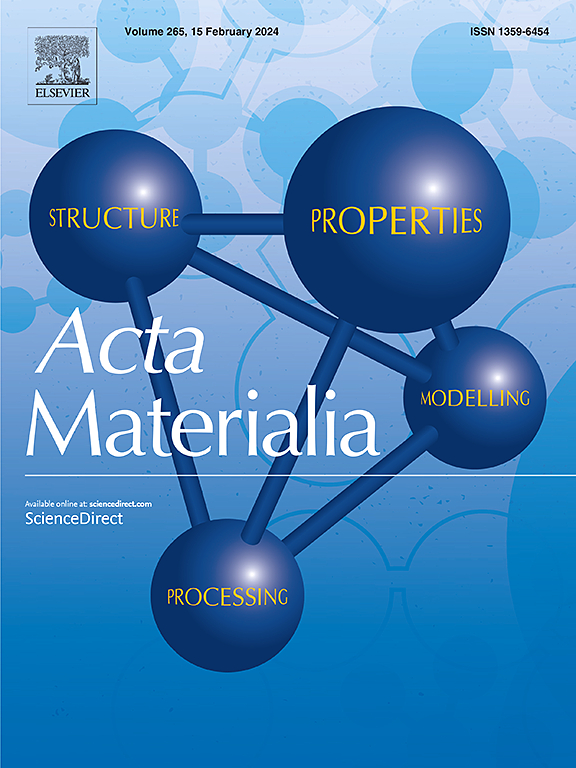Dynamic fracture response of Cantor-derived medium entropy alloys
IF 8.3
1区 材料科学
Q1 MATERIALS SCIENCE, MULTIDISCIPLINARY
引用次数: 0
Abstract
The dynamic behavior for five Cantor-derived alloys with four elements in equiatomic composition was investigated. The composition was systematically modified to: CrMnFeNi, MnFeCoNi, CrMnCoNi, CrMnFeCo, and CrFeCoNi. Under identical homogenization, deformation, and recrystallization processing conditions, these materials exhibited significant differences in the microstructure and the corresponding mechanical response, which was measured through uniaxial stress compression loading at strain rates ranging from 10−4 to 103 s−1. Additionally, spall recovery experiments were performed at strain rates of ∼104 s−1 to further understand the effect of strain rate on damage and failure in tension. Four of the five alloys were face-centered cubic and exhibited ductile failure by void nucleation, growth, and coalescence, primarily at the grain boundaries. Surprisingly, the significant differences in compressive strength (ranging from ∼200 to ∼600 MPa at 10−4 s−1) did not manifest themselves in the spall strength, which varied from 2.08 to 2.61 GPa (not including the CrMnFeCo alloy). This is attributed to similar processes of void growth, which occur at the scale of a few micrometers and do not incorporate the mesoscopic response (such as Hall-Petch), which determines the yield strength. One of the alloys, CrMnFeCo, exhibited especially low ductility in compression and fragmented into pieces during both compression and spall testing. This behavior was attributed to the formation of a brittle Sigma-like phase. The effect of both chemistry and processing was observed to affect the specific spall strength and damage evolution. Specifically, Cr segregation at the grain boundaries had a deleterious effect. This study provides a template for the choice of superior dynamic response among high and medium entropy alloys.


康托尔衍生中熵合金的动态断裂响应
研究了五种四元素等原子组成康托尔合金的动力学行为。将该组合物系统修饰为:CrMnFeNi、MnFeCoNi、CrMnCoNi、CrMnFeCo、CrFeCoNi。在相同的均质化、变形和再结晶工艺条件下,通过应变速率为10−4 ~ 103 s−1的单轴应力压缩加载,测量了这些材料的微观结构和相应的力学响应。此外,为了进一步了解应变速率对拉伸损伤和破坏的影响,在~ 104 s−1的应变速率下进行了剥落恢复实验。五种合金中有四种是面心立方合金,主要在晶界处表现出空洞形核、生长和聚结的延性破坏。令人惊讶的是,抗压强度的显著差异(在10−4 s−1下从~ 200到~ 600 MPa)并没有体现在颗粒强度上,颗粒强度从2.08到2.61 GPa不等(不包括crmneco合金)。这是由于类似的空洞生长过程,发生在几微米的尺度上,不包括介观响应(如Hall-Petch),而介观响应决定了屈服强度。其中一种合金,CrMnFeCo,在压缩和剥落测试中表现出特别低的延展性,并且破碎成碎片。这种行为归因于脆性sigma样相的形成。研究发现,化学反应和工艺处理对材料的比剥落强度和损伤演化均有影响。具体来说,晶界处的铬偏析产生了有害的影响。该研究为高、中熵合金的动态响应选择提供了模板。
本文章由计算机程序翻译,如有差异,请以英文原文为准。
求助全文
约1分钟内获得全文
求助全文
来源期刊

Acta Materialia
工程技术-材料科学:综合
CiteScore
16.10
自引率
8.50%
发文量
801
审稿时长
53 days
期刊介绍:
Acta Materialia serves as a platform for publishing full-length, original papers and commissioned overviews that contribute to a profound understanding of the correlation between the processing, structure, and properties of inorganic materials. The journal seeks papers with high impact potential or those that significantly propel the field forward. The scope includes the atomic and molecular arrangements, chemical and electronic structures, and microstructure of materials, focusing on their mechanical or functional behavior across all length scales, including nanostructures.
 求助内容:
求助内容: 应助结果提醒方式:
应助结果提醒方式:


